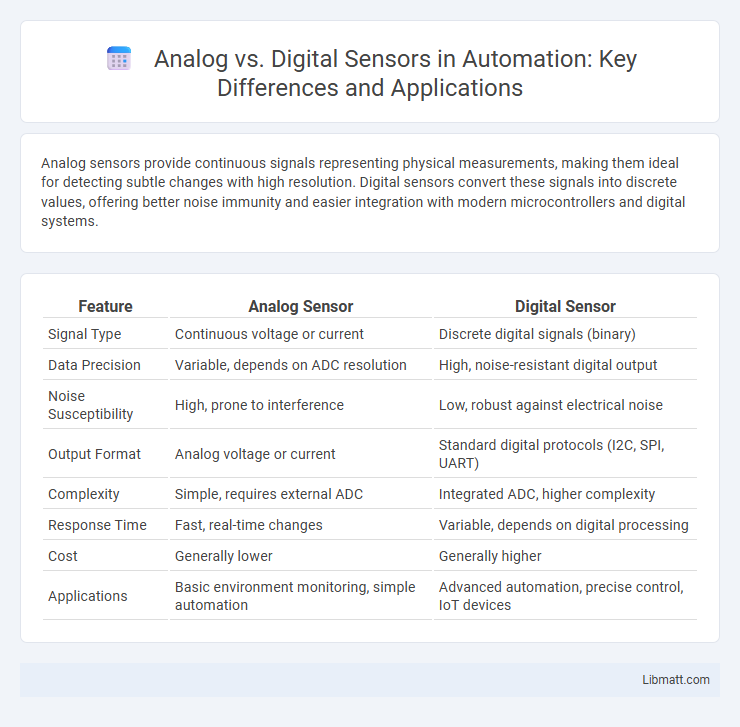Analog sensors provide continuous signals representing physical measurements, making them ideal for detecting subtle changes with high resolution. Digital sensors convert these signals into discrete values, offering better noise immunity and easier integration with modern microcontrollers and digital systems.
Table of Comparison
| Feature | Analog Sensor | Digital Sensor |
|---|---|---|
| Signal Type | Continuous voltage or current | Discrete digital signals (binary) |
| Data Precision | Variable, depends on ADC resolution | High, noise-resistant digital output |
| Noise Susceptibility | High, prone to interference | Low, robust against electrical noise |
| Output Format | Analog voltage or current | Standard digital protocols (I2C, SPI, UART) |
| Complexity | Simple, requires external ADC | Integrated ADC, higher complexity |
| Response Time | Fast, real-time changes | Variable, depends on digital processing |
| Cost | Generally lower | Generally higher |
| Applications | Basic environment monitoring, simple automation | Advanced automation, precise control, IoT devices |
Introduction to Analog and Digital Sensors
Analog sensors continuously capture physical quantities and convert them into varying electrical signals, which represent a range of values. Digital sensors instead interpret these inputs into discrete digital signals, offering precise on/off or binary data output. Understanding the difference in data formats helps you select the most appropriate sensor type for your specific application and data accuracy requirements.
Key Differences Between Analog and Digital Sensors
Analog sensors provide continuous signals that vary proportionally with the measured physical quantity, allowing for precise measurement but requiring complex signal processing. Digital sensors output discrete binary signals representing specific thresholds or values, offering easier integration with microcontrollers and reduced noise interference. Key differences include signal type (continuous vs. discrete), data accuracy (variable vs. fixed), and communication methods (analog voltage/current vs. digital communication protocols like I2C or SPI).
Working Principles of Analog Sensors
Analog sensors operate by converting physical parameters such as temperature, pressure, or light intensity into continuous, variable electrical signals that correspond proportionally to the measured quantity. These sensors typically use sensing elements like thermistors, resistive strain gauges, or photodiodes which change their electrical properties in response to environmental changes. The resulting analog voltage or current output can be directly measured, providing a precise representation of the real-world phenomenon before any signal conversion or processing.
Working Principles of Digital Sensors
Digital sensors operate by converting physical stimuli such as temperature, pressure, or light into discrete digital signals using integrated analog-to-digital converters (ADCs). These sensors process and output data in binary form, enabling precise, noise-resistant measurements suitable for microcontrollers and digital systems. Their working principles rely on sampling the analog input at specific intervals, quantizing the signal, and transmitting the resulting digital data for further analysis or control applications.
Accuracy and Precision Comparison
Analog sensors provide continuous signals that offer high resolution, but their accuracy can be affected by noise and signal degradation over distances. Digital sensors produce discrete signals with precise, repeatable outputs, minimizing errors caused by interference and ensuring consistent accuracy. Your choice depends on application requirements, as analog sensors excel in fine measurement detail, while digital sensors deliver superior precision and reliability in data transmission.
Signal Processing Requirements
Analog sensors generate continuous signals that require amplification, filtering, and analog-to-digital conversion for accurate processing and interpretation. Digital sensors produce discrete, binary signals that can be directly processed by microcontrollers or digital systems, reducing the need for extensive signal conditioning. The choice between analog and digital sensors significantly impacts the design complexity and accuracy requirements of the signal processing circuitry.
Advantages of Analog Sensors
Analog sensors offer continuous signal output, providing precise and real-time measurement of physical quantities such as temperature, pressure, and light intensity. They excel in applications requiring smooth, high-resolution data without the need for complex digitization processes. The simplicity of analog sensor design often results in lower cost and faster response times compared to digital counterparts.
Advantages of Digital Sensors
Digital sensors offer enhanced accuracy and reduced noise interference compared to analog sensors, ensuring precise data measurement and reliable performance. They provide straightforward integration with microcontrollers and digital systems through standardized interfaces like I2C or SPI, making your development process more efficient. Additionally, digital sensors support advanced features such as self-calibration and built-in diagnostics, improving overall system functionality and maintenance.
Common Applications of Analog vs Digital Sensors
Analog sensors are widely used in applications requiring continuous signal monitoring, such as temperature measurement in HVAC systems, light intensity detection in photography, and pressure sensing in automotive engines. Digital sensors find common applications in smart devices, including motion detection in security systems, proximity sensing in smartphones, and digital encoding in robotics for precise control. Both sensor types are essential for industrial automation, with analog sensors providing real-time variable data and digital sensors enabling accurate discrete signal processing.
Choosing the Right Sensor for Your Application
Choosing the right sensor for your application depends on factors such as accuracy, signal processing, and environmental conditions. Analog sensors provide continuous signals ideal for real-time monitoring and precise measurement, while digital sensors offer discrete signals with built-in processing and easier integration with microcontrollers. Evaluate the application's requirements for resolution, noise tolerance, and interface compatibility to select either an analog or digital sensor that maximizes performance and reliability.
Analog vs Digital Sensor Infographic

 libmatt.com
libmatt.com